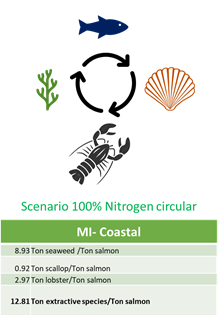Circularity
Circularity of the IMTA systems
Through the multi-trophic systems, some of the uneaten feed and wastes, nutrients, and by-product are recaptured and converted into harvestable and healthy seafood. Nitrogen recycling in IMTA is especially important as nitrogen in the form of plant nutrients or protein is a valuable resource usually requiring high energy inputs to manufacture as fertiliser or convert to protein. IMTA makes use of a free source of nitrogen otherwise wasted. Therefore, the cultivation components have a key role in recycling processes within the IMTA.
In IMPAQT, emissions of nutrients have been estimated in both, monoculture and IMTA conditions once extractive species are deployed in the farms. Considering theoretical conditions to achieve 100% of nitrogen circularity, work in the IMPAQT project estimated the biomass requirement for a specific pilot case – where they farmed salmon, seaweed scallops, and juvenile lobsters. To do so, nitrogen total emissions from salmon monoculture have been calculated through the mass balance model reported in the literature (Wang, et al., 2012), while absorption from extractive species has been estimated considering nitrogen content in seaweed, lobsters, and scallops. Regarding seaweed, the nutritional analysis is taken as the basis for nutrient content calculation. For scallops and lobsters, nitrogen content table nutritional analysis and Barrento, et al., 2009 have been used.
The image shows total biomass needed to bioremediate 100% of Nitrogen emitted in the case study. Lobster, algae and scallop’s biomass have been calculated considering equal bioremediation potential (1/3 each species) as a theoretical approach.
Creation of circular value in IMTA systems
Given that IMTA systems create value around circularity in aquaculture, facilitating access to government-issued operating permits is a necessary first action. Training and understanding of both, biological processes and technological level are relevant actions to ensure the circularity of the production in terms of recirculation of nutrients.
Systems also require to be monitored to confirm that the multi-cultivation conditions are optimal, not only related to environmental parameters but also to operational indicators. Consequently, the monitoring enables to make decisions to optimise production to create value around the circularity in the farms.
The creation of marketing and distribution opportunities for IMTA products is very necessary to promote IMTA. Finally, fundraising in all specific activities around IMTA is a key and essential activity to create circular value.
The resources needed to perform key activities are identified and presented. Resources needs are basically defined attending to the characteristics of the pilot’s partners in the context of the project, but the feedback obtained fairly reflect the reality of aquaculture farms regarding IMTA systems.
Partners needed for the implementation of circular aquaculture practices based on IMTA model are identified in the following figure. All value chains are represented through these actors, from regulators, system designers to customers. Standards organizations are identified as important partners to examine opportunities, such as promoting IMTA products as eco-products, in line with organic standards or any other available scheme currently recognised by the consumers. Strategy alliances with marketing companies are recommended, for the promotion of IMTA activities and products as a circular solution in the sector. Moreover, researchers represent a relevant role, since there is still a wide field to explore in terms of monitoring, modelling and assessment of the circularity in IMTA.

Value proposition in circular IMTA systems
In line with the definition of circular solutions suggested in literature, IMTA producer might be classified as circular suppliers since IMTA products underpin circular production where resources are recycled. Given that circularity is a driver for sustainability, the circularity of IMTA product might be one of the most important reasons why these products are best suited for a market segment defined by “eco-friendly” product consumers.
The value that IMTA companies deliver to this segment of customers is based on the sustainable attributes of the seafood, consequently, the value proposition of IMTA products might be defined looking at:
- How IMTA products incorporate elements of circular economy?
- What is the environmental value of IMTA products delivered to customers?
- What is the socio-economic value of IMTA products delivered to customers?
As circularity is a driver for sustainability, it is quite relevant to demonstrate how nutrient cycling leads to the reduction of environmental burdens as part of the optimal implementation of IMTA. To do so, the optimization of feeding systems together with the monitoring of the nutrient flows along the trophic levels would contribute to ensuring the circularity within the production cycle.
IMTA systems may be attractive due to their improved environmental performance. However, reporting the performance of IMTA products in relation to many different impact categories may confuse consumers and the environmental profile should be properly assessed, ideally verified, and correctly communicated to consumers. The communication of key indicators agreed by the IMTA sector that could be easily understandable should be focused on. Particularly, climate change and eutrophication are standard indicators that reflect the environmental profile and ensure the comparison between seafood product delivered by IMTA or monoculture practices.
IMTA products involve a high strengthening on the awareness of the consumers/business stakeholders about the sustainability and the quality of the product, representing around half of the capital and operational expenditure; a reduction in seasonality problems due to smooth production cycles; new indirect gains to companies supplying goods and services; and an increase in the community economies impact.
References
Barrento, S. et al., 2009. Nutritional quality of the edible tissus of European Lobster Homarus gammarus and American Lobster Homarus Americanus. Journal of Agricultural and Food Chemisitry, Volume 57, pp. 3645-3652.Wang, X., Mork Olsen, L., Inge Reitan, K. & Olsen, Y., 2012. Discharge of nutrient wastes from salmon farms: environmental effects, and potential for integrated multi-trophic aquaculture. Aquaculture Environment Interactions, Volume 2, pp. 267-283


